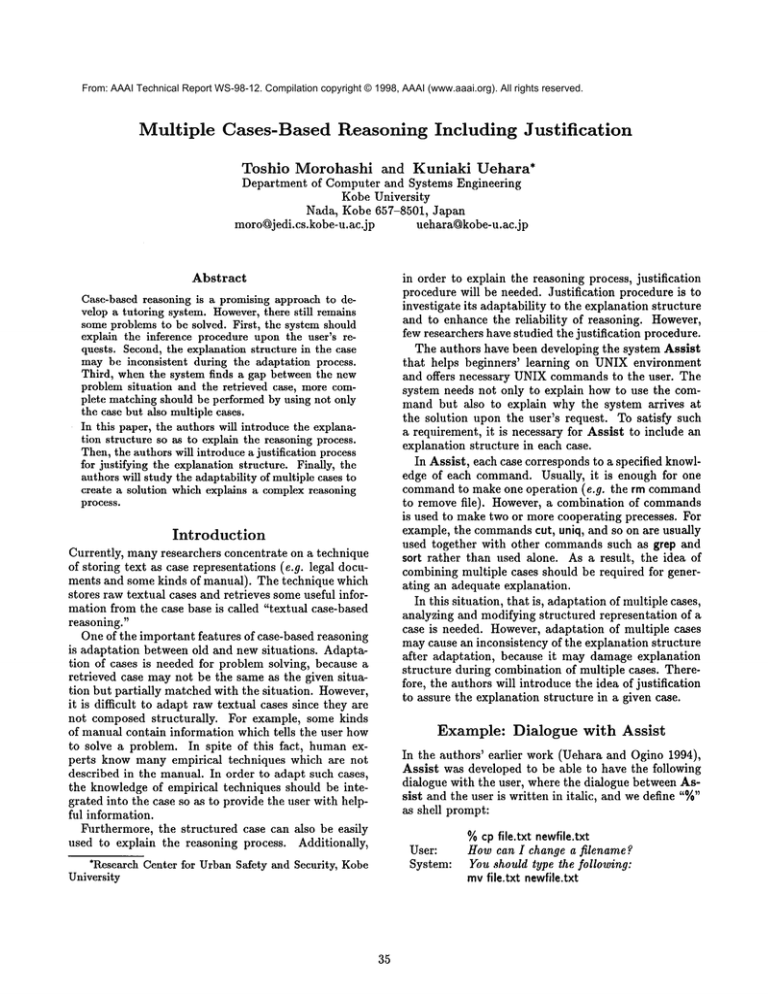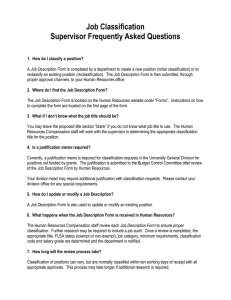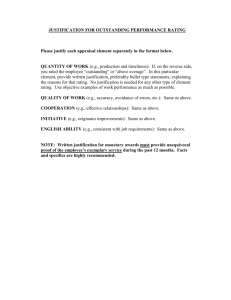
From: AAAI Technical Report WS-98-12. Compilation copyright © 1998, AAAI (www.aaai.org). All rights reserved.
Multiple
Cases-Based
Toshio
Reasoning
Morohashi
Including
and Kuniaki
Justification
Uehara*
Department of Computer and Systems Engineering
Kobe University
Nada, Kobe 657-8501, Japan
moro@jedi.cs.kobe-u.ac.jp
uehara~kobe-u.ac.jp
Abstract
in order to explain the reasoning process, justification
procedure will be needed. Justification procedure is to
investigate its adaptability to the explanation structure
and to enhance the reliability
of reasoning. However,
few researchers have studied the justification procedure.
The authors have been developing the system Assist
that helps beginners’ learning on UNIXenvironment
and offers necessary UNIXcommandsto the user. The
system needs not only to explain how to use the command but also to explain why the system arrives at
the solution upon the user’s request. To satisfy such
a requirement, it is necessary for Assist to include an
explanation structure in each case.
In Assist, each case corresponds to a specified knowledge of each command.Usually, it is enough for one
commandto make one operation (e.g. the rm command
to remove file). However, a combination of commands
is used to make two or more cooperating precesses. For
example, the commandscut, uniq, and so on are usually
used together with other commandssuch as grep and
sort rather than used alone. As a result, the idea of
combining multiple cases should be required for generating an adequate explanation.
In this situation, that is, adaptation of multiple cases,
analyzing and modifying structured representation of a
case is needed. However, adaptation of multiple cases
maycause an inconsistency of the explanation structure
after adaptation, because it may damage explanation
structure during combination of multiple cases. Therefore, the authors will introduce the idea of justification
to assure the explanation structure in a given case.
Case-based reasoning is a promising approach to develop a tutoring system. However,there still remains
someproblems to be solved. First, the system should
explain the inference procedure upon the user’s requests. Second, the explanation structure in the case
maybe inconsistent during the adaptation process.
Third, whenthe system finds a gap between the new
problem situation and the retrieved case, more complete matching should be performed by using not only
the case but also multiple cases.
In this paper, the authors will introduce the explanation structure so as to explain the reasoning process.
Then,the authors will introduce a justification process
for justifying the explanation structure. Finally, the
authors will study the adaptability of multiple cases to
create a solution which explains a complexreasoning
process.
Introduction
Currently, manyresearchers concentrate on a technique
of storing text as case representations (e.g. legal documents and some kinds of manual). The technique which
stores raw textual cases and retrieves someuseful information from the case base is called "textual case-based
reasoning."
One of the important features of case-based reasoning
is adaptation between old and new situations. Adaptation of cases is needed for problem solving, because a
retrieved case may not be the same as the given situation but partially matched with the situation. However,
it is difficult to adapt raw textual cases since they are
not composed structurally.
For example, some kinds
of manual contain information which tells the user how
to solve a problem. In spite of this fact, human experts know many empirical techniques which are not
described in the manual. In order to adapt such cases,
the knowledge of empirical techniques should be integrated into the case so as to provide the user with helpful information.
Furthermore, the structured case can also be easily
used to explain the reasoning process. Additionally,
Example: Dialogue
with Assist
In the authors’ earlier work (Uehara and Ogino 1994),
Assist was developed to be able to have the following
dialogue with the user, where the dialogue between Assist and the user is written in italic, and we define "%"
as shell prompt:
User:
System:
*Research Center for Urban Safety and Security, Kobe
University
35
%cp file.txt newfile.txt
Howcan I change a filename?
You should type the following:
myfile.txt newfile.txt
Assist receives the lines followed by % as the user’s
commandhistories. Commandhistories are a sequence
of UNIXcommands which was typed just before the
user’s utterance. It provides information on the user’s
intentional behavior that cannot be obtained from the
user’s utterance. For example:
User:
Explanation
Justification
%ps -aux
%kill pid
I can’t kill the process.
You should type the following:
kill (its process number)
User:
It is a meaningless solution, because the user does not
obtain any new problem-solving situation.
However,
Assist can obtain information from the commandhistories. That is to say, Assist can infer that the user
knows the kill commandand its process number. On
the basis of this information, Assist can answer the
question as follows:
System:
System:
User:
System:
You should type the following:
kill -9 (its process number)
Howcan I browse only the tenth line from
a file ?
You should type the following:
head -10 foo.txt I tail -1
Thank you. But ....
Why do you use "head -10"?
I use the commandto display the first 10
lines of the foo.tzt.
In this case, the system has an explanation structure
(Figure 1). The system can indicate the process of why
the head commandwas used before the tail command.
The explanation process is as follows: First, the system
points to the nodes head and -10, and searches for links
with respect to the two nodes. As a result, the system
reaches the node line 1-10 and finally creates the sentence, "I use the commandto display the first 10 lines
of the foo.tzt ."
However, consider the following example:
User:
System:
Including
In the authors’ earlier research, the system tried to retrieve the exact single case indexed by both user utterance and commandhistories.
However, even if the
system gives the user an adequate commandto satisfy
the user’s request, the user maycomplain why the system arrives at such a solution. Therefore, the authors
will introduce the explanation structure which is used
to trace the procedure of how the system led to the
solution. As a result, the user can ask the system for
details whenthe user is not satisfied with the answer.
For example, consider the following dialogue:
Assume that Assist does not consider the command
histories, then the answer maybe the following:
System:
Structure
%rmdir
Why?I can’t remove the directory dir.
You should type the following:
rm-r dir
In this case, in spite of obtaining the command
histories
according to the user’s request, Assist cannot provide
an adequate explanation of what the user desires. In
other words, the user’s request is "why" isn’t this command correct?, and it means that what the user wants
to know is the reason why the commandwas not executed correctly and how Assist generated the answer.
In this situation, Assist should explain the reason why
the user failed to use the commandand the way to recover from the failure.
I ~ process flow
Needs of Cases Including
Justification
It is important to answer the user’s request and to explain the process of case-based reasoning, because the
user may ask why the system generated such a solution. The system needs to store the process in order to
explain the system’s capability. In other words, representing the inference process indicates the range of the
system’s capability and reliability of its solution.
To solve this problem, we will introduce "explanation structure." It is possible to reuse this explanation
structure if the system solves the problem and stores
the process of problem solving. In addition, it is also
possible to confirm the adaptability of cases by justifying each explanation structure in a given case. It means
that "justification" is the ability to confirm the adaptability of the matching case to the problem situation.
| NIKLnetwork ~/)ustification
Figure 1: Explanation structure of "head -101 tail -1."
At this point, each node associated with the commandprocedure is justified. Justifying the explanation
is performed by tracing down a semantic network. That
is to say, the network allows the system to create an
explanation and assures the result. Wewill call such
assurance "justification."
Figure 1 shows an explanation structure to explain
the command,head and tail, where each node is linked
by some arrows: a process flow, the NIKLnetwork, and
justification link. A process flow is represented by bold
arrows. The other arrows represent semantic network
for justifying explanation structure, where justifying an
36
explanation structure is defined as follows: Given a successful process of one UNIXcommand,a justification
link is drawn to justify the reasoning process with respect to the command.
The authors have utilized the idea of the NIKLnetwork (Neches, Swartout, and Moore 1985) to describe
the semantic network. The justification link is associated with the NIKLnetwork. NIKLhas the usual complement of representational devices, such as concepts,
roles on concepts, and links between concepts indicating
subsumption. It is used to investigate whether the justification link is pointing the command
procedure to its
corresponding result after adapting cases with respect
to its semantics.
Figure 2 shows a simple NIKLnetwork, where double
arrows indicate a-kind-of relations, while single arrows
indicate attributes of concepts. Thus, in Figure 2, a file
is defined to be a file system with a has-contents role
that must be filled by contents, while text-file has its
has-contents role filled by written contents.
Figure 3: Example of example case.
This answer maysatisfy the user’s request; however, if
"words" appears at so manyplaces in all files in the
working directory, the user can just see only the last
part of the grep list. As a result, the user has to solve a
new problem, that is, howto browse all the greo list. In
this situation, Assist has the following reminding case:
%Is-al I more
This combination of commands,which utilizes "1", i.e.
a pipe command, to create two or more cooperating
commandprocesses, enables the user to see one screenful at a time when the commandreturns a standard
output larger than the screen on a terminal. This reminding case can be adapted to the all commandsthat
output a result of the procedure on a terminal, e.g. ps,
nkf, zcat. Then an example case with respect to the
grep command should be merged with the reminding
case. As a result, Assist obtains the following:
% grep words * I more
Figure 2: Simple NIKLnetwork.
In this situation, if the grep list is short enough, the
more command is an unnecessary procedure and the
user may ask the reason why the system arrives at the
solution. The system can explain the reason by using
explanation structure as follows:
Using Multiple
Cases
Components
of Cases
In a tutoring system, pre-stored cases can be used as examples that can be offered to the user to help in solving
a new problem. For the system itself, these cases can
be used to analyze and to classify problem solutions.
However, a different situation occurs when the system
is supposed to monitor the problem solving process of
a human expert user. Then, episodes from the user’s
own learning history consisting of solutions to problem
solving tasks may serve as remindings (Weber 1994).
On the basis of this idea, we will deal with two types of
cases, that is, the example case and the reminding
case.
The example case is a basic case to solve a problem. If the user treats Assist as the electric manual
or on-line help system, it has enough capability. Figure
3 shows an example case which describes the rm command, where justification link is not described for the
sake of simplicity. While the reminding case is an empirical case which is obtained from experts’ techniques,
they are not usually described in the manual.
For example, Assist can answer the following request
by using the example case:
User:
System:
System:
Too long list unable to display on one
screen, more command was recommended.
Thus, combining reminding cases and the example cases
enable the system to answer questions on more complex
situations.
It is important how the system combines
and adapts these multiple cases.
Combination
of Multiple
Cases
Case-based reasoning is a method which uses stored
cases as a guide to solving new problems. Given a
new problem, the best case is retrieved from stored
cases, and similarities between the retrieved case and
the problem situation are identified. These similarities
are used to adapt the retrieved case to fit the problem
situation. While adapting the retrieved case, additional
case is also used to cover a lack of knowledge(Sycara
and Navinchandra 1991). On the basis of the idea, we
will propose to use multiple cases for solving a problem.
In combining multiple cases, the adaptation process
consists of three steps: Step I is to select the best match
case by comparing the index between the problem situation and each case. Step 2 is to eliminate redundant
Howcan I find "words’~ in this directory?
You should type the ]ollowing:
% grep words *
37
parts of the best match case. Step 3 is to fill the gap
between the problem situation and the best match case
by using additional cases cMled cover cases. These steps
are repeated until the index of the best match satisfies
the problem situation.
In Figure 4, the procedure for Step 1 retrieves the
Best Match Case for Problem Situation,
because it
has the same indices (A, B, C, and D) except
The procedure for Step 2 eliminates superfluous composition of Best Match Case, that is, index F. The
procedure for Step 3 fills the gap index E between
ProblemSituationand Best MatchCase by adding
Cover Case with indices D and E. A new structural
solution can be given by combining Best Match Case
and CoverCase.
Figure 5: Exampleof eliminating psnupto dvi2ps I Ipr.
[Problem
Situation]
index[A,B,C,D,E
]
elimination[F]
[B~t MatchCase]
~ [Best Match Case]
index[A,B,Ci~
m index[A,S,C,D,E]
[CoverCase]
iodex[D,E,G]
which is a higher node with respect to the NIKLnetwork. Therefore, its justification
is maintained, and
the system obtains a correct explanation structure. It
is also certain that justification to the dvi2ps command
is maintained, because the dvi-file node is still linked to
the dvi2ps procedure after elimination.
addition[D,E]
Figure 4: Combination of Multiple Cases.
Example
2
Consider another situation where the system retrieves a
reminding case and inserts another cover case to satisfy
the problem situation. Supposethat the user has a data
file which has some kinds of words and wants to know
the number of times that each word occurs in its file.
As a result of retrieval, the system obtains the following
cases, where BMCstands for the best match case and
CCs are cover cases:
BMC: cat foo.txt uniq -c
CCs:
psselect -p2,5 foo.ps bar.ps
CCs:
sort foo. txt
CCs: vi
Adaptation
of Multiple
Cases
In this section, we will consider adaptation of multiple cases. During the adaptation process, it is difficult to maintain explanation structure correctly, because adding and eliminating cases may create inconsistent explanation structures. Therefore, we will add
and eliminate part of a case in consideration as follows:
Partial elimination of case If part of a reminding
case is eliminated, its explanation structure maybe
broken. Therefore, the system has to investigate
whether it is possible to eliminate the explanation
structure which corresponds to part of the case.
Addition of case Some covering cases may be added
to reminding cases. If the reminding cases are reconstructed as a result of addition, they are also justified
according to their semantic networks.
I
The system attempts to complement BMC,cat [ uniq,
with CCs, psselect, but the consistency of its explanation structure maybe broken, because the justification
link does not point the correct node. The result is
shown in Figure 6. The two nodes, contents and selected ps-file, are not justified from the result of commands, psselect and uniq, because it is necessaxy for the
input contents node to be pointed to the uniq procedure by justification link in order to justify a command
procedure. Weconsider the node contents in Figure 6;
the justification link of the psselect commanddoes not
point out the node contents but the node ps-file which is
incorrect for justifying its commandprocedure. Therefore, this explanation structure from the procedure of
the psselect commandis judged to be inconsistent.
As a result of the judgment, the system attempts
to complement the BMCwith the next CCs, i.e. sort
(Figure 7). In this case, it is possible to justify the
two nodes contents and sorted contents by the result of
their processes. In consequence, the final output is a
Example
1
Wewill consider a situation where the system selects
a reminding case which consists of dvi2ps, psnup, and
Ipr commands, and eliminates a portion of the psnup
commandfrom the case (Figure 5). The explanation
structure of the reminding case may be broken by the
lack of an intermediate node after elimination. Therefore, the system has to investigate its consistency of the
explanation structure.
In this case, justification is still maintained for each
command, Ipr and dvi2ps, before and after elimination. In Figure 5, for example, consider justification
link for the Ipr command,the justification link points
the Ipr procedure to the separated ps-file node. After
elimination, justification link points to the ps-file node
38
the case base and have shownthe effectiveness of utilizing these multiple cases. The authors have integrated
them in the adaptation process of case-based reasoning
and have shown that justification preserves the adaptability of multiple cases. Therefore, we can conclude
that this integration works well for complex problemsolving cases.
At present, the authors are working on the user’s utterance and commandhistories as case indices for retrieval. For another indexing candidate, the authors
will consider a "standard error message" which is returned by a UNIXsystem. If such messages are treated
as indices that indicate the reason for failure, we will
be able to explain the user’s failure more strictly.
Here, we know a similar approach that is called
"derivational analogy." It proceeds through the reasoning steps in the construction of the past solution
and considers whether they are still appropriate in the
new situation or whether they should be reconsidered
in light of significant differences between two situations (Carbonell 1986). In derivational analogy, Carbonell proposed a procedure called "failure-cause propagation" in its derivational trace. If we adopt this
idea, the system will be permitted to explain the user’s
failure-cause.
Furthermore, in derivationai analogy, to modify a
plan accurately and efficiently, knowledge compilation
and decompilation techniques are proposed. If we can
adopt knowledgecompilation, we will be able to control
explosion in increasing the numberof cases.
~l ’°p"’I ou,p.tI I iopotlo.,p.t I
~ ~ riot
justified
Figure 6: Exampleof inconsistency in adding case.
file that is affected by both sorted and uniqed contents,
and higher-level concept uniqed-sorted-contents is created. This is enough to explain the process, and the
system can answer the following request:
System:
You should type the following:
cat foo.txt I sort I uniq -c
User:
Why is the sort commandrequired?
System: As uniq removes only adjacent duplicate
lines, a sorted data is necessary.
In this case, although two different cases are combined,
the system can explain the reason for the necessity of
the sort command.It is because, after adaptation, explanation structure is connected by the semantic network, and it indicates consistency in explanation.
References
Uehara, K. and Ogino, H.: A Case-Based Approach
to Text Planning, Proc. of the IASTEDInternational
Conference on Artificial Intelligence, Expert Systems
and Neural Networks, pp.123-127 (1994).
Neches, R., Swartout, W. R. and Moore, J. D.: Enhanced Maintenance and Explanation of Expert Systems Through Explicit Models of Their Development,
IEEE Transactions on software engineering, Vol.SE-11.
No.ll, pp.1334-1350 (1985).
have
~ nput
~Tfl output I
I"rD~NIsTDO~
IISTD~NISTDOUr
I
I output
II
input
Weber, G.: Methods and Tools: Examples and Remindings in a Case-based Help System, Advances in
Case-Based Reasoning, Lecture Notes in Artificial Intelligence, Vol.984, pp.165-177(1994).
Sycara, K. P. and Navichandra, D.: Index Transformation Techniquesfor Facilitating Creative use of Multiple
Cases, Proe. of 1Pth IJCAL pp.347-354 (1991).
Carbonell, J, G.: Derivational Analogy: A Theory of
Reconstructive Problem Solving and Expertise Acquisition, R. S. Michalski, J. G. Carbonell and T. M.
Mitchell (eds.) Machine Learning, VolumeII, pp.371392, Morgan Kaufmann (1986).
Figure 7: Exampleof adaptation of multiple cases.
Conclusions
In this paper, the authors have presented the necessity
of including explanation structure and justification in
39





